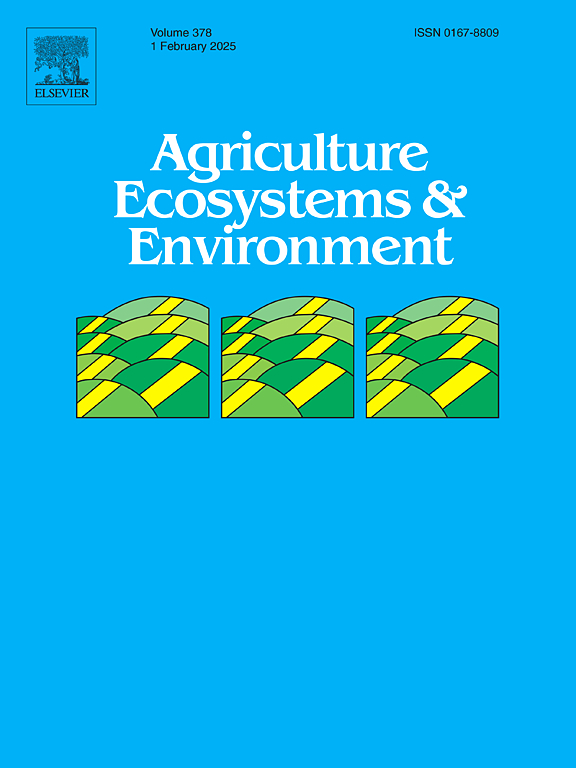Divergent responses of soil aggregation and aggregate-carbon to fertilization regimes jointly explain soil organic carbon accrual in agroecosystems: A meta-analysis
IF 6
1区 农林科学
Q1 AGRICULTURE, MULTIDISCIPLINARY
引用次数: 0
Abstract
Soil aggregation can be substantially affected by fertilizers and contributes to soil organic carbon (SOC) sequestration in agroecosystems. However, the mass and C distributions in different aggregates in responses to fertilization regimes are not often synchronous, which may largely affect soil C storage and stability. We conducted a meta-analysis of 2440 paired observations from 63 publications to assess the fertilization effects (i.e. inorganic, organic, and their combinations) on soil aggregation and aggregate-associated OC, as well as their linkages to the stimulated bulk soil C. Overall, fertilizer application significantly increased the mean weight diameter of soil aggregates by 27.8 %. The proportion of large (> 2 mm) and small (0.25–2 mm) macroaggregates were significantly increased by 19.8 % and 17.2 %, and that of microaggregate (0.053–0.25 mm) and silt-clay fraction (< 0.053 mm) were significantly decreased by 6.0 % and 18.4 %, respectively. In contrast, fertilization significantly increased C concentration in all aggregates. Organic fertilizer applications had remarkably greater effects than inorganic fertilizer applications on soil C concentration but the effects declined with decreasing aggregate size (from 36.5 % to 13.2 %), while that of inorganic application changed very little among aggregates (from 14.1 % to 10.0 %). The fertilizer effects on soil aggregation and aggregate-associated OC divergently responded to the gradients of major agronomic conditions (i.e. climate, soil properties, and duration). Organic fertilizer applications tended to have distinctly greater promotion effect than solely inorganic fertilizer applications with temperate climate, neutral-to-alkaline pH and more sand-like texture of soil. The importance of mineral- rather than larger size aggregate-associated OC in contributing to the bulk SOC pool tended to increase in the long term. The inorganic-organic combinations exhibited the most lasting effect on SOC accrual. In conclusion, the responses of bulk soil C to fertilizer applications were not always in accordance with those of soil aggregation, but can be well explained when jointly considering soil aggregate C. Our findings highlight the varying contributions of aggregates to the soil C pool in diverse and complicated agronomic situations, which are important to the agricultural C sink stability.
土壤团聚和团聚碳对施肥制度的不同反应共同解释了农业生态系统中土壤有机碳的累积:荟萃分析
土壤团聚会受到肥料的很大影响,并有助于农业生态系统中土壤有机碳(SOC)的固存。然而,不同团聚体的质量和碳分布对施肥机制的响应往往并不同步,这可能会在很大程度上影响土壤碳的储存和稳定性。我们对 63 篇文献中的 2440 个配对观测数据进行了荟萃分析,以评估施肥(即无机肥、有机肥及其组合)对土壤团聚体和团聚体相关 OC 的影响,以及它们与受激发的土壤C总量之间的联系。大团聚体(> 2 mm)和小团聚体(0.25-2 mm)的比例分别显著增加了 19.8 % 和 17.2 %,微团聚体(0.053-0.25 mm)和粉土-粘土部分(< 0.053 mm)的比例分别显著减少了 6.0 % 和 18.4 %。与此相反,施肥则能明显提高所有集料中的碳浓度。施用有机肥对土壤碳浓度的影响明显大于施用无机肥,但随着团聚体大小的减小,有机肥的影响也在减小(从 36.5% 降至 13.2%),而施用无机肥对不同团聚体的影响变化很小(从 14.1% 降至 10.0%)。肥料对土壤团聚和团聚体相关有机碳的影响随主要农艺条件(即气候、土壤特性和持续时间)的变化而变化。在温带气候、pH 值为中性至碱性、土壤质地为沙土的条件下,施用有机肥的促进作用明显大于施用无机肥。从长远来看,矿物质而非更大粒径的聚合有机碳对大量有机碳库的贡献越来越大。无机-有机组合对 SOC 累积的影响最为持久。总之,大体积土壤碳对施肥的反应并不总是与土壤团聚体的反应一致,但如果共同考虑土壤团聚体碳,则可以很好地解释这一点。
本文章由计算机程序翻译,如有差异,请以英文原文为准。
求助全文
约1分钟内获得全文
求助全文
来源期刊

Agriculture, Ecosystems & Environment
环境科学-环境科学
CiteScore
11.70
自引率
9.10%
发文量
392
审稿时长
26 days
期刊介绍:
Agriculture, Ecosystems and Environment publishes scientific articles dealing with the interface between agroecosystems and the natural environment, specifically how agriculture influences the environment and how changes in that environment impact agroecosystems. Preference is given to papers from experimental and observational research at the field, system or landscape level, from studies that enhance our understanding of processes using data-based biophysical modelling, and papers that bridge scientific disciplines and integrate knowledge. All papers should be placed in an international or wide comparative context.
 求助内容:
求助内容: 应助结果提醒方式:
应助结果提醒方式:


